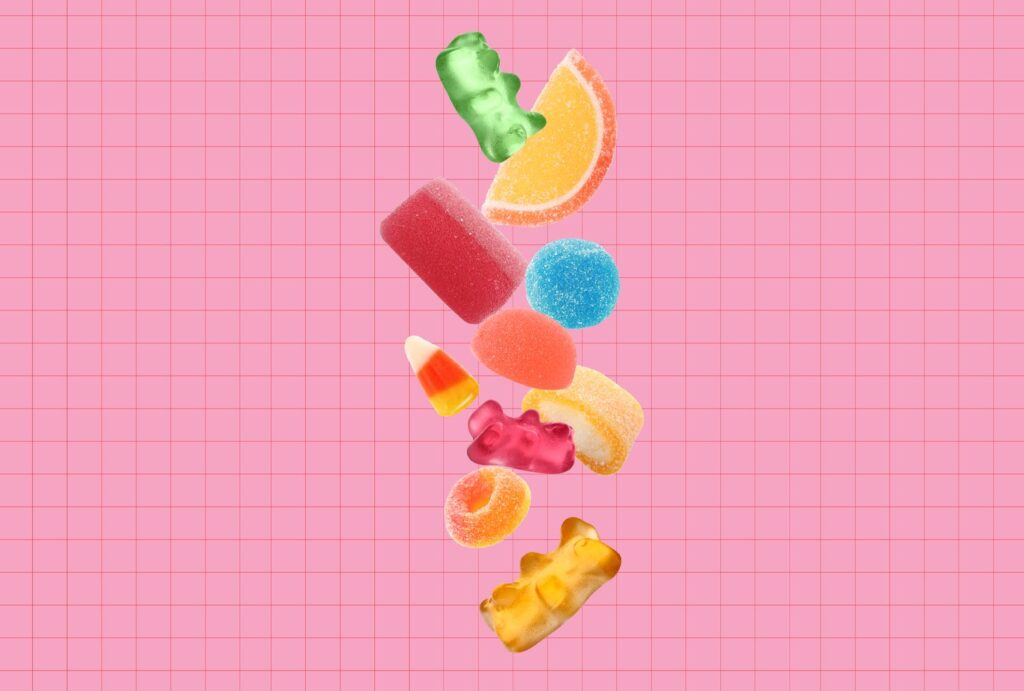- The candy aisle is increasingly filled with healthy-sounding options.
- These may be better alternatives for some people, but that doesn’t mean they’re healthy.
- All kinds of candy can be a nice treat on occasion as part of a balanced eating plan.
The candy aisle has recently exploded with seemingly better-for-you options. Chocolates with no added sugar, dye-free gummies, even jelly beans that promise extra protein. With all the varieties of “natural” or “healthy” candy available, you might wonder if these treats are really better for you, a marketing gimmick or something somewhere in the middle?
“When I think of something that’s ‘healthy,’ I think of nutrient-dense foods—those that provide vitamins, minerals, fiber and protein that help fuel our bodies,” says Alex Turnbull, RDN, LD. Candy doesn’t necessarily fit that mold. So, is “healthy” candy any better for you? The answer may depend on your unique health goals and needs.
To find out the details, we dug into the options, talked to registered dietitians and broke down the science around “healthy” candy and when it may—or may not—be a better choice.
What Is “Healthier” Candy Made Of?
First and foremost, there is no official definition of “healthy” candy. However, there are many candies that market themselves as being healthier. And there’s quite a variety of different strategies and tactics to capture a more health-conscious but candy-loving audience.
Clara Nosek, M.S., RDN, notes they often are made with “lower carbohydrates, no added sugar, lower sugar, added fiber, high protein, no artificial dyes or no seed oils.” Here are just a few of the more common categories of candy marketed as being healthier (sometimes a product might fit into multiple categories).
Lower-Sugar Candy
The most common way to healthify a candy seems to be to use less sugar or none at all. These may be sweetened with natural or artificial sweeteners, such as stevia, sugar alcohols or allulose.
“Natural” Candy
These candies are often made with no artificial dyes. Or, they may use cane sugar instead of high-fructose corn syrup. Sometimes there is less added sugar than the amount in more typical varieties.
Candy with Added Benefits
Many newer candy lines tout extra ingredients that claim to help with something. That can range from added fiber and protein to ginseng and caffeine.
Is “Healthier” Candy the Better Option?
It’s hard to definitively say if one of these candies is better for you than another. Candy is candy. What about those healthier-sounding ingredients? “To actually see a benefit from those ‘better-for-you’ ingredients, you’d have to eat a lot more of them, which defeats the purpose,” says Turnbull. “The amount of candy we typically eat is so small that swapping ingredients doesn’t make a meaningful nutritional difference.”
That said, some people may benefit from eating some of these products instead of regular candy. For example, lower-sugar candy may be a better option for people with diabetes. However, the American Diabetes Association notes that even foods made with sugar substitutes and sugar alcohols can still deliver lots of calories. Alternatively, people with sensitivities to artificial colors may fare better with naturally colored candy.
However, moderation still matters. “At the end of the day, whether it’s made with organic sugar or artificial colors, it’s still candy, and it’s best enjoyed in small amounts,” says Turnbull.
Potential Risks
While there may be some benefits to “healthier” candies, there are also some downsides. Nosek states, “The healthier candies are often more expensive, taste different (read: not good), and sometimes they’re not as visually appealing.” Turnbull adds that these “healthier” versions may cause digestive issues if they contain sugar alcohols or added fiber.
There’s also the health halo effect. That’s where people believe something is better for them and may eat more, or forget that there is also added sugar or lots of calories in the food that they are eating.
Should You Limit Regular Candy?
You do want to limit the amount of added sugar you eat, including candy. The Dietary Guidelines for Americans recommend no more than 10% of your calories come from added sugar, which is about 50 grams, or roughly 13 teaspoons, for someone who eats 2,000 calories a day. The American Heart Association recommends even less, around 25 to 36 grams (6 to 9 teaspoons) for women and men. To put that into perspective, most Americans eat around 17 teaspoons daily, with the biggest sources of added sugar being sweetened drinks and desserts. If you’re wondering where candy fits in, it makes up around 9% of our added sugar intake.
While Nosek acknowledges she tries to stick to recommendations, she also doesn’t set strict limits around candy in her house. “Candy can always be added to a meal,” she says. “Very early on, both kids learned what eating only candy feels like. It’s always out and accessible, and my kids aren’t candy fiends. If anything, it’s made them very particular about the candy they do eat.”
“Candy can absolutely fit into a balanced diet,” says Turnbull. “We should be including the foods we truly love, but it’s more about the frequency and context, not strict limits.” She recommends mini-size candies to help naturally keep added sugars in check while still being able to enjoy a few small pieces.
Our Expert Take
Only you can decide what your favorite candy is going to be. If you choose a “healthier” option because it fits your needs, just know that it’s still candy. “Any candy can be healthfully added to a dietary pattern,” notes Nosek, adding that carbohydrates in your diet will ideally come from fruits, vegetables and whole grains. The key is to enjoy the candy you do eat, as a small part of a larger foundation of more nutritious foods. As Turnbull says, “Candy isn’t meant to be healthy—it’s meant to be fun! And that’s OK.”

